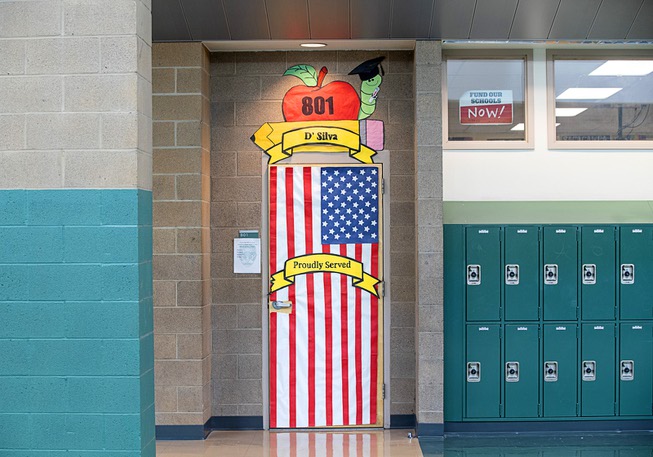
The door to history teacher Reuben D’Silva’s classroom is shown at Rancho High School Tuesday, Nov. 15, 2022. Students decorated the classroom doors of military veterans for Veterans Day. D’Silva is the newly-elected assemblyman for Assembly District 28.
Friday, June 30, 2023 | 2 a.m.
View more of the Sun's opinion section
It should have been obvious to Clark County School District officials that something was amiss when they reported that graduation rates for the North Las Vegas region came in 30 points lower than the rest of the district.
Journalists from across the region should have questioned the disparity and taken the time to ask questions and review the data before publishing headlines lambasting one region of the county. After all, that is quite literally their job as journalists. And teachers who are members of the Clark County Education Association (CCEA), many of whom work in North Las Vegas schools, should have led by example by thinking critically and independently, questioning respectfully and using thoughtful analysis to defend their students and their teaching practices.
Instead, district officials, CCEA and journalists blindly accepted that North Las Vegas had a graduation rate of only 51.5% this past year, a claim made by CCSD officials in their quarterly report to the County Commission. CCEA tweeted a statement that repeated the claim and, just like that, the headlines proclaiming that only half of North Las Vegas students graduated spread like wildfire across the valley.
But unlike CCSD and CCEA officials or her colleagues in other newsrooms, the Sun’s Hillary Davis immediately recognized that something was off. Several days of dogged questioning by Davis revealed that CCSD’s data suffered from a systemic error that made the results extremely biased and misleading.
If evaluated using the same data points and metrics as the rest of the district, not only would North Las Vegas’ graduation rate be more than 30% higher than the district reported (82.3%), it would actually be a full percentage point better than the district as a whole (81.3%).
North Las Vegas’ data was skewed because it included nearly 2,000 adult learners who did not earn a diploma from CCSD’s high school completion program. The program is based in North Las Vegas, but its students are adults from across the country who dropped out of high school years or even decades earlier and now live in Southern Nevada.
Not only is the data misleading, but it also paints a low-income portion of the district where two-thirds of families are Latino or Black as being less academically astute than wealthier and often whiter peer groups.
As the local research analytics company Data Insight Partners posted in a Twitter thread questioning the report, including the adult learners “blows up North Las Vegas’ student count by almost 50% and creates a completely misleading (and) irresponsible metric that stokes bigoted notions of race (and) poverty.”
We agree.
We hope this mistake was simply sloppiness by CCSD — a mistake for which a high school student would get a D — rather than the product of a more nefarious motivation. Unfortunately, the motivations of the district staff who prepared the report and those who repeated and amplified it to the public are largely irrelevant. As advocates for racial and economic justice have long pointed out, even unintentional mistakes committed by well-meaning people can still contribute to negative stereotypes and beliefs.
Communities like North Las Vegas, which has a higher percentage of low-income and Black and brown residents than many other parts of Las Vegas, are especially vulnerable to these types of negative perceptions and associations.
Despite raising their graduation rate to 92% in the year before the COVID pandemic, district officials, teachers, journalists and even some parents had no reservations about blindly accepting that North Las Vegas schools had dipped to a mere 51.5%.
A KTNV headline declared “Some parents are ‘not surprised’ by report saying only half of North Las Vegas students graduated last year.” The story contained quotes from parents whose children transferred or dropped out of North Las Vegas schools but did not contain any quotes from parents of current North Las Vegas students.
Please don’t misunderstand us: There are real conversations to be had about the ongoing crisis in public education here in Clark County and across the country. The shortage of teachers, bus drivers and support staff pose real threats to our society’s ability to deliver quality education. Rural schools are running out of time and options to repair crumbling, asbestos-laden schools. And everything from mass shootings to climate change are contributing to rising rates of anxiety and declining mental health among students.
The result of these and other challenges is that math and reading proficiency scores that were already trending down pre-pandemic are dropping even more quickly post-pandemic. According to data released by the National Assessment of Educational Progress, the gold-standard federal exam, the math and reading performance of 13-year-olds in the United States has hit the lowest level since 1990. And here in Clark County, nearly 1 in 5 CCSD students fail to graduate on time. Those are disturbing trends that must be addressed.
But to address these challenges, we must understand them, and that means getting reliable data that paints an accurate picture of what problems the district is facing and where those problems are most pronounced. CCSD failed to achieve that objective with its latest report. CCEA and regional journalists compounded that failure by amplifying it without question.
Teaching our children to be independent thinkers who engage in data-driven critical analysis requires more than just fixing our schools and classrooms. It also requires us, the adults in the room who claim to value these skills, to lead by example.
